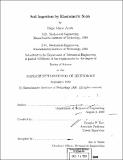| dc.contributor.advisor | Douglas P. Hart. | en_US |
| dc.contributor.author | Ayala, Hugo M. (Hugo Mario) | en_US |
| dc.contributor.other | Massachusetts Institute of Technology. Dept. of Mechanical Engineering. | en_US |
| dc.date.accessioned | 2009-06-30T18:45:25Z | |
| dc.date.available | 2009-06-30T18:45:25Z | |
| dc.date.copyright | 1999 | en_US |
| dc.date.issued | 1999 | en_US |
| dc.identifier.uri | http://hdl.handle.net/1721.1/46270 | |
| dc.description | Thesis (Sc.D.)--Massachusetts Institute of Technology, Dept. of Mechanical Engineering, 1999. | en_US |
| dc.description | Includes bibliographical references (p. 157-160). | en_US |
| dc.description.abstract | Studies of elastomeric seal failure have until recently focused on the erosion of the sealing interface. This has limited the improvements in seal life to the application of wear-resistant materials. The present work shows that three stages of particle ingestion precede seal erosion, and that seals designed to interfere with each stage exhibit substantially longer operational life. The three stages of failure preceding seal erosion are as follows. The first stage occurs when small soil particles creep into the contact gap. These particles are so small (< 0.1 microns) that they accumulate in the surface valleys of the seal without damaging it. The second stage occurs as the shearing motion of the seal pushes the increasing number of entering particles against each other and short-range forces bind the particles into clusters. As more particles enter the seal, the clusters grow in size. Eventually, the clusters become so large that they no longer fit in the surface valleys of the seal. The third stage occurs when the clusters start rolling between the seal and its mating surface. The rolling pushes clusters further into the contact band until they fall freely into the oil. It is at this point that material erosion becomes the rate-limiting mechanism leading to failure. This work contains a description of the apparatus and techniques used in investigating seal failure; results of test for various seal lip designs, material composition, and operating parameters; images showing results the oil-film thickness measurements by means of laser-induced fluorescent; and estimates of contact pressure by finite-element simulations. | en_US |
| dc.description.statementofresponsibility | by Hugo Mario Ayala. | en_US |
| dc.format.extent | 161 p. | en_US |
| dc.language.iso | eng | en_US |
| dc.publisher | Massachusetts Institute of Technology | en_US |
| dc.rights | M.I.T. theses are protected by
copyright. They may be viewed from this source for any purpose, but
reproduction or distribution in any format is prohibited without written
permission. See provided URL for inquiries about permission. | en_US |
| dc.rights.uri | http://dspace.mit.edu/handle/1721.1/7582 | en_US |
| dc.subject | Mechanical Engineering. | en_US |
| dc.title | Soil ingestion by elastomeric seals | en_US |
| dc.type | Thesis | en_US |
| dc.description.degree | Sc.D. | en_US |
| dc.contributor.department | Massachusetts Institute of Technology. Department of Mechanical Engineering | |
| dc.identifier.oclc | 44390404 | en_US |
